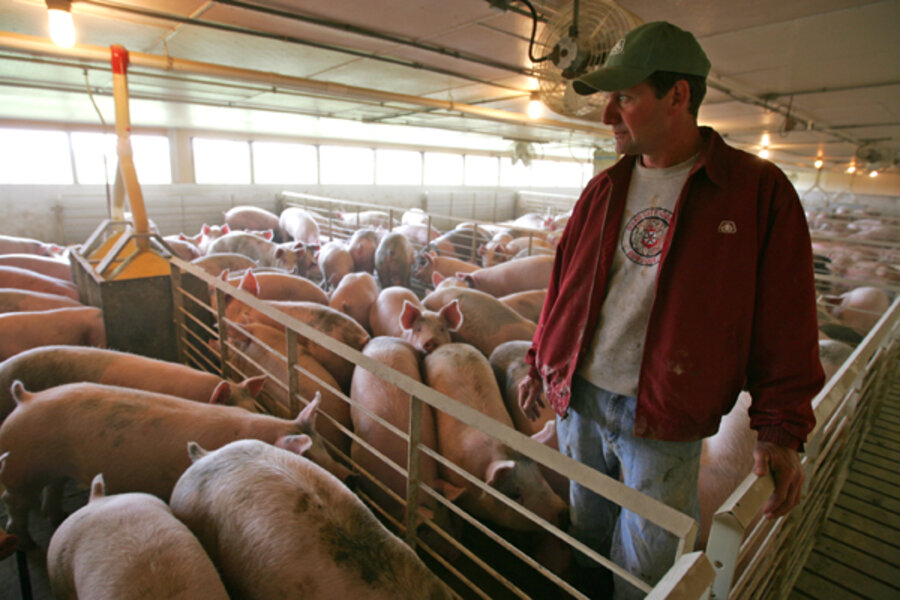Why can't US pig farmers profit from the pork revolution?
| Atlanta
Smoked pig ears, sliced and served like french fries with ketchup. Hog jowl sandwiches. Downmarket taco joints serving braised pork belly with freshly julienned slaw.
At the American kitchen and restaurant table, 2009 was the year of the pig – all of it, apparently. Shanks and jowls jostled with filet mignon for top billing on many top restaurant menus. Bacon made a comeback, even getting its own bacon news aggregator and finding its way into ice cream and candy. And home chefs – too cash-strapped to buy haddock and perhaps a bit tired of pan steaks – found inspiration in braised bellies and slow-roasted Boston butt.
But if "the other white meat" became the main meat this year, a paradoxical market challenge remains: Despite year over year growth of 3.1 percent as both chicken and beef sales fell off, US pork producers kept losing nearly $25 per animal. Myriad factors played into the troubles, such as a 16 percent drop in international sales (swine flu being one issue there), stubbornly high feed corn prices (due to ethanol), and – what else is new? – zealous investors who failed to see a looming downturn as they bred record numbers of sows in 2005 and 2006.
Pack up the pork parade
To make matters worse, just as pig farmers are ready to finally bring home some profit in 2010 on the lean hog and pork belly futures exchange, some gourmands are boldly declaring that the pork parade is over. At least one foodie site, Epicurious.com, proclaims that pork will be passé in 2010. (“We love pork, but when every corner cafe has a bacon-wrapped item on the menu, it’s time for something new,” according to the site.)
“Yes, during recessions, lower cost meats typically do better than higher cost cuts, and for restaurants especially it provides an opportunity to put out an entrée at a lower cost,” says Ron Plain, an agricultural economist at the University of Missouri in Columbia. “But the fact is, the hog industry has had a very, very tough stretch in ’08 and ’09, and it will continue into early 2010, and then hopefully get better.”
From cooking shows to magazines to the corner restaurant, the pig couldn’t have had a bigger year. It embodied frugal times, and provided near infinite modification opportunities at the stove. Pork harks to simpler times, especially in the South, where whole pig roasts are still much-cherished annual events, and where vinegary dirty sauces are splashed on chopped BBQ shoulder in porky reverie.
Bacon, bacon, bacon
These days, the web is full of bacon news. There’s the tidbit from the Netherlands where scientists have grown pork in the lab (though scientific rules preclude them from tasting their creation, so who knows whether it’s any good). Bacon blogs are hot (i.e. MrBaconPants).
And for a real treat, bacon has inspired mad scientist chefs to new levels. Witness the turbaconducken, brought to you by the foodies at Bacon Today.
Rarer cuts like osso bucco and even “pig wings” – a chicken wing-like cut from the ham – have enticed restaurant owners ready to take a look at cheaper raw product that will still enchant and satiate their customers.
“People are finding that, 'Wow, we can do a lot of different stuff with pork,' and it’s a great time to try it." says Don Nikodim, executive vice president of the Missouri Pork Association.
Yet it is the vagaries of the global economy more than how much turbaconducken Americans eat that will determine the health of the US pork industry. Like everyone else, pig farmers are waiting for a turnaround, and aim to be in better position for recovery once it comes.
“We should be back in higher prices in 2010, fewer hogs in 2010, hopefully a better US economy and world economy by 2010, so we’re cautiously optimistic, as the politicians like to say,” says Mr. Plain, the pork economist.
-----
Follow us on Twitter.





